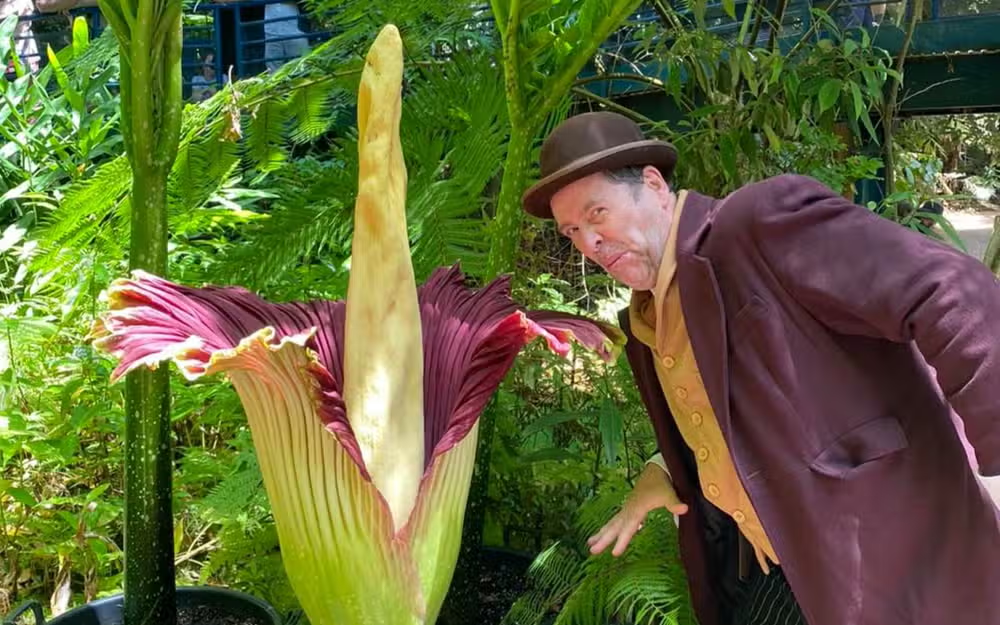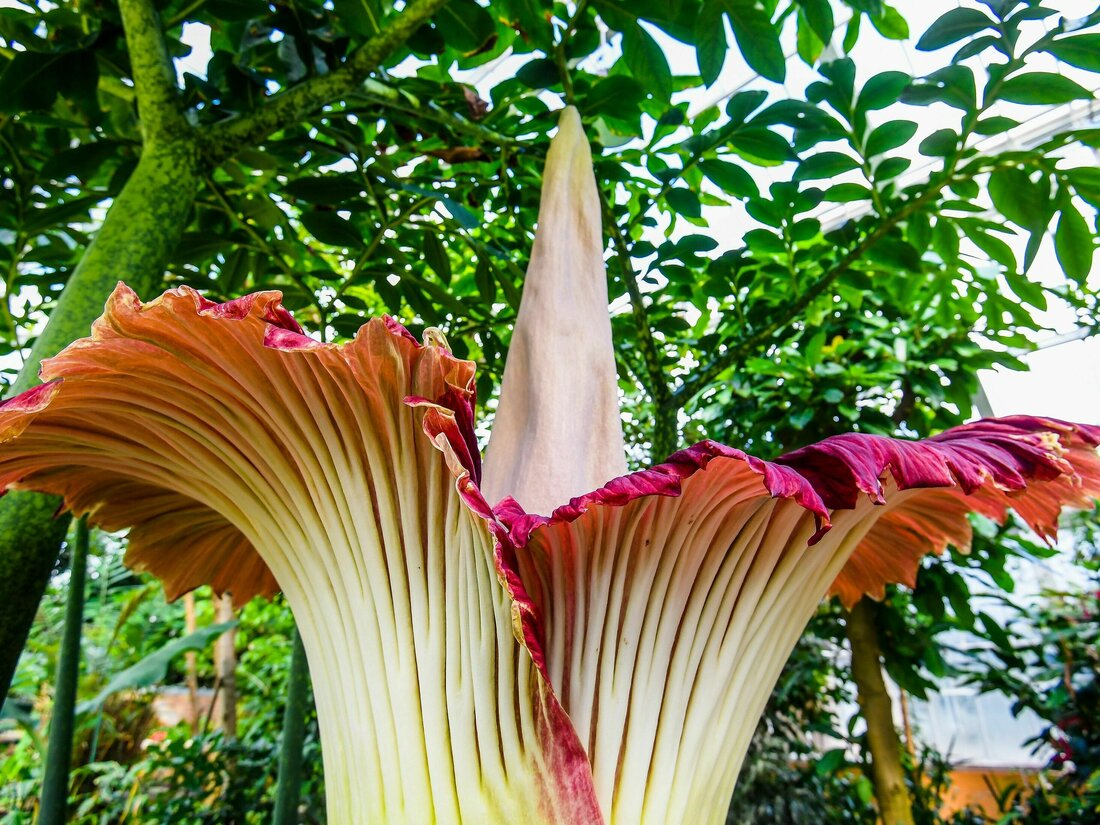The rare and unusual Corpse Flower Blooms, also known as Amorphophallus titanum or Titan Arum, is making headlines in Geelong, Australia, where it has just bloomed for the first time since being gifted to the Geelong Botanic Garden.
This spectacular event has drawn thousands of curious visitors eager to witness and experience the flower’s most defining feature – its powerful and putrid odor. With the bloom expected to last only 24 to 48 hours, this rare spectacle is a fleeting opportunity, and people are flocking to the garden in droves.
The Alluring and Horrible Smell of the Corpse Flower Blooms
The corpse flower is infamous for the foul stench it releases when it blooms, a scent that has been described by visitors as resembling decaying animals. It’s no surprise that one of the primary attractions of the Titan Arum is its overpowering odor, which is likened to the smell of dead possums, rotting fish, or even a dead mouse.
Some children even bluntly described the stench as “smelly pond water.” The odor serves a crucial purpose for the flower: it attracts pollinators such as beetles and flies that are drawn to the scent of decay.
When the Titan Arum opens up, it releases a mix of sulfur compounds and other volatile compounds that mimic the smell of rotting flesh. The plant produces this odor to attract specific pollinators that are attracted to decomposing matter, thus facilitating its reproduction process.
Interestingly, the bloom occurs unpredictably, sometimes occurring only once every decade. This sporadic blooming pattern is a major reason why the corpse flower is so highly anticipated when it does flower. Its pungent smell, coupled with its rarity, has earned it an almost mythical status among horticulturists and plant enthusiasts.
Read : Neelakurinji Flowers Bloom in Nilgiri After 12 Years
The Geelong Botanic Garden in Australia is now part of this myth, having received the gift of a Titan Arum in 2021 from the State Herbarium in Adelaide. Since then, horticulturists have eagerly watched for any signs of the plant’s bloom. It wasn’t until Monday, November 11, that the flower finally bloomed, triggering an immediate surge in visitors.
On that first day, about 5,000 people crowded into the garden to get a glimpse of the spectacle. Many visitors shared their experiences, detailing the overwhelming and revolting nature of the flower’s aroma. Despite the discomfort of the smell, many visitors chose to stay for extended periods, marveling at the flower’s unusual structure and dramatic unfolding.
The bloom of the corpse flower is a multi-stage process, with visitors returning to the botanic garden multiple times to watch the plant’s slow transformation. The bloom begins with the gradual unfurling of the frilly leaves surrounding the flower’s central spadix.
For those who weren't there to smell it, watch as Cosmo the corpse flower blooms 👀
— Colorado State University (@ColoradoStateU) May 28, 2024
Thousands flocked to #ColoradoState over Memorial Day weekend to see a rare corpse flower during a bloom that was eight years in the making.
Learn and see more ➡️ https://t.co/2n82CGF40H pic.twitter.com/GPCmrqgsej
This spadix, a tall yellow column, is where the flower’s hundreds of tiny flowers are located. Over time, the base of the spadix closes up around the flowers, signaling the end of the bloom. Those fortunate enough to witness each stage of the flower’s opening have found it to be a mesmerizing, albeit stinky, process. The bloom itself is short-lived, making it a rare and valuable event for plant lovers and curious tourists alike.
The Importance of Titan Arum Conservation
While the Titan Arum is a spectacle to behold, it is also an endangered species that is under serious threat in its native habitat. The plant is native to Indonesia, particularly the tropical rainforests of Sumatra. However, deforestation and land degradation have severely impacted its natural environment.
The destruction of these forests for timber, paper, and oil palm plantations has resulted in the decline of many native species, including the corpse flower. The International Union for Conservation of Nature (IUCN) lists the plant as “endangered,” with only a few hundred plants remaining in the wild. The Geelong Botanic Garden’s blooming Titan Arum is a part of global efforts to conserve this incredible species.
Despite its endangered status, the Titan Arum can live for up to 30 to 40 years. However, due to its infrequent blooming cycle, it may only bloom a handful of times in its lifetime. This makes every bloom a significant event. Conservationists and botanists are working together to protect the plant both in the wild and in botanic gardens around the world.
Several botanic gardens have taken it upon themselves to cultivate and protect Titan Arum plants, ensuring that the species does not disappear entirely. In fact, this is part of a larger effort to preserve plant biodiversity and maintain ecosystems that are essential for the health of the planet.

The Geelong Botanic Garden’s recent bloom highlights the importance of preserving rare and endangered species, not only for scientific research but also for their role in maintaining the delicate balance of our ecosystems. The work being done in botanic gardens around the world, including those in Australia, is vital for the survival of species like the Titan Arum, which depend on human intervention to thrive in captivity and to raise awareness about their declining populations.
A Global Spectacle: The Cultural and Educational Impact
In addition to its biological and ecological significance, the Titan Arum bloom in Geelong has become a cultural event, drawing attention from across the globe. As the bloom began on November 11, the Geelong Botanic Garden set up a livestream, enabling viewers from around the world to witness this rare event.
According to the City of Greater Geelong, the livestream has already garnered tens of thousands of views, with people tuning in from countries across the world. The international interest in the bloom underscores the growing fascination with rare and unusual plant species, as well as the public’s interest in conservation issues.
The livestream not only allows plant enthusiasts to participate in this unique event from the comfort of their homes, but it also serves as an educational tool. It gives viewers a chance to learn about the biology of the plant, its ecological importance, and the conservation efforts underway to protect it. Additionally, the bloom provides a visual spectacle for those who may never have the opportunity to visit the botanic garden in person.
Fair to say there is some extreme interest in Geelong’s so-called corpse plant, or ‘amorphophallus titanum’, for those playing at home. It flowers every decade and lasts just 24-48 hours. Those on the way out of the botanic gardens report dry-retching. pic.twitter.com/0zYExprGcm
— Henry Belot (@Henry_Belot) November 11, 2024
In this way, the Titan Arum’s bloom becomes more than just a botanical curiosity; it is an opportunity for global engagement and education. People from different cultures and backgrounds can come together to appreciate the wonder of nature, while also acknowledging the importance of preserving our planet’s biodiversity.
The Geelong Botanic Garden’s role in this educational mission reflects the critical function that botanic gardens play in the conservation movement, ensuring that rare and endangered species are protected, studied, and shared with the world.
A Rare Event Worth the Wait
The rare and fleeting bloom of the Titan Arum at the Geelong Botanic Garden is a reminder of the beauty and strangeness of the natural world. Though the flower’s foul odor may deter some, its rarity and the global interest it generates make it a highly anticipated event.
For those fortunate enough to witness the bloom in person, it is an unforgettable experience that combines the wonder of nature with the reality of conservation challenges. The ongoing efforts to protect the species in botanic gardens around the world ensure that future generations will have the chance to experience this rare and extraordinary event.
As the bloom fades, the Geelong Botanic Garden’s livestream continues to capture the attention of plant lovers and conservationists worldwide, showcasing the importance of preserving our planet’s most unique and endangered species.
let’s enjoy few years on earth with peace and happiness….✍🏼🙏

